Laboratory Evaluation on Performance of Compound-Modified Asphalt for Rock Asphalt/Styrene–Butadiene Rubber (SBR) and Rock Asphalt/Nano-CaCO3
Abstract
:1. Introduction
2. Materials
2.1. Materials
2.2. Preparation of Modified Asphalt
3. Tests and Results
3.1. The Evaluation of the Thermal Stability and Aging Resistance for Modified Asphalt
3.1.1. Thermal Stability
3.1.2. Aging Resistance
3.2. The Evaluation of Low-Temperature Performance for Modified Asphalt
3.2.1. Test of Creep Compliance
3.2.2. Bending Beam Rheometer Test
3.2.3. Results of Creep Test
- (1)
- Comparison under the same temperature
- (a)
- With the increase of the amounts of SBR, the creep compliance of BRA/SBR compound-modified asphalt will be increased, which means that SBR can improve the flexibility of BRA-modified asphalt. So, the low-temperature performance of BRA-modified asphalt can be improved.
- (b)
- The creep compliance of BRA/nano-CaCO3 compound-modified asphalt slightly increased with an increase of the mixing amount of nano-CaCO3 at the same temperature, which means that the low-temperature performance of BRA/nano-CaCO3 compound-modified asphalt slightly improved. Moreover, the improving effect of nano-CaCO3 on the low-temperature performance of BRA-modified asphalt was less obvious when the temperature was lower.
- (2)
- Comparison under same time
- (a)
- When the temperature was lowered, the compliance of two kinds of BRA compound-modified asphalt decreased, and the modified asphalt hardened.
- (b)
- The creep compliance of BRA/SBR polymer compound-modified asphalt was larger than BRA-modified asphalt.
- (c)
- As the temperature decreased, the creep compliance of BRA/nano-CaCO3 compound-modified asphalt was close to that of BRA. It means that the improving effect of nano-CaCO3 on the low-temperature performance of BRA-modified asphalt was not obvious.
4. Viscoelastic Damage Model Considering the Damage Effect
4.1. The Establishment of Viscoelastic Damage Model Considering the Damage
4.2. Fitting Results of Viscoelastic Damage Model
- (a)
- The coefficient of determination R2 between the model and test data shown in Table 7 indicated that the fitting degree of test data and creep compliance of viscoelastic damage model is very precise. So, considering the effect of microdefects during the loading process can improve the precision in the prediction of viscoelastic parameters of compound-modified asphalt.
- (b)
- As shown in Figure 11a,b,d, the viscoelastic parameters (E1, E2 and η2) of BRA compound-modified asphalt increased as the temperature decreased, which indicated that the low-temperature performance of the material decreased. Among the viscoelastic parameters, E2 and η2 had the same change trend as the temperature decreased, so both have good correlation with each other.
- (c)
- In three test temperatures, the viscoelastic parameters (E1, E2, and η1) of BRA compound-modified asphalt, in which 5% SBR was the smallest among the test conditions, indicated that SBR could improve the flexibility and low-temperature performance of BRA-modified asphalt. The difference of viscoelastic parameters between BRA/nano-CaCO3 compound-modified and BRA-modified asphalt is not obvious, which indicated that nano-CaCO3 couldn’t effectively improve the low-temperature performance of BRA-modified asphalt.
5. Conclusions
- The suitable addition of nano-CaCO3 and SBR can improve the thermal stability and without negative effects to the aging resistance of BRA-modified asphalt to some extent. The anti-rutting performance of 10% BRA/nano-CaCO3 compound-modified asphalt was the best. The thermal cracking performance of 5% BRA/SBR-modified asphalt has been effectively improved, and that of nano-CaCO3 is not obvious.
- The prediction accuracy of the viscoelasticity for compound-modified asphalt has been raised by the improved Burgers’ model, and considered the effect of damage. The creep compliance shows a good agreement with the experimental results, so it can be applied to analyze the viscoelasticity of compound-modified asphalt.
- The viscoelastic parameters (E1, E2 and η1) of BRA compound-modified asphalt increased with the decrease of temperature, which indicated that the flexibility of the material decreased.
Author Contributions
Funding
Acknowledgments
Conflicts of Interest
References
- Lv, S.; Liu, C.; Yao, H.; Zheng, J. Comparisons of synchronous measurement methods on various moduli of asphalt mixtures. Constr. Build. Mater. 2018, 158, 1035–1045. [Google Scholar] [CrossRef]
- Lv, S.; Liu, C.; Chen, D.; Zheng, J.; You, Z.; You, L. Normalization of fatigue characteristics for asphalt mixtures under different stress states. Constr. Build. Mater. 2018, 177, 33–42. [Google Scholar] [CrossRef]
- Zhang, C.; Wang, H.; You, Z.; Liu, Y.; Yang, X.; Xiao, J. Prediction on rutting decay curves for asphalt pavement based on the pavement-ME and matter element analysis. Int. J. Pavement Res. Technol. 2017, 10, 466–475. [Google Scholar] [CrossRef]
- Lv, S.; Fan, X.; Xia, C.; Zheng, J.; Chen, D.; You, L. Characteristics of Moduli Decay for the Asphalt Mixture under Different Loading Conditions. Appl. Sci. 2018, 8, 840. [Google Scholar] [CrossRef]
- Li, R.; Karki, P.; Hao, P.; Bhasin, A. Rheological and low temperature properties of asphalt composites containing rock asphalts. Constr. Build. Mater. 2015, 96, 47–54. [Google Scholar] [CrossRef]
- Lv, S.; Wang, X.; Liu, C.; Wang, S. Fatigue Damage Characteristics Considering the Difference of Tensile-Compression Modulus for Asphalt Mixture. J. Test. Eval. 2018, 46, 20170114. [Google Scholar] [CrossRef]
- Huang, W. Experimental Investigation into Pavement Performance of Buton Rock Asphalt Mixtures. J. South China Univ. Technol. 2012, 208, 122–135. [Google Scholar] [CrossRef]
- Yin, Y.M.; Zhang, X.N. Research on high temperature rheological characteristics of asphalt mastics with indonesian buton rock asphalt (BRA). J. Wuhan Univ. Technol. 2010, 32, 85–89. [Google Scholar] [CrossRef]
- Ruixia, L.I.; Hao, P.; Wang, C.; Zhang, Q. Modified Mechanism of Buton Rock Asphalt. J. Highw. Transp. Res. Dev. 2011, 12, 4. [Google Scholar]
- Du, S.W. Performance and mechanism of BRA-SBS polymer composite modified asphalt mixture. J. Build. Mater. 2012, 15, 871–874. [Google Scholar]
- Hadiwardoyo, S.P.; Sinaga, E.S.; Fikri, H. The influence of Buton asphalt additive on skid resistance based on penetration index and temperature. Constr. Build. Mater. 2013, 42, 5–10. [Google Scholar] [CrossRef]
- Wang, H.B.; Zhe-Sheng, G.E. Test of Dynamic Rheology Properties of Buton Rock Asphalt Modified Asphalt Cement at High-temperature. J. Highw. Transp. Res. Dev. 2008, 9, 25. [Google Scholar]
- Kocevski, S.; Yagneswaran, S.; Xiao, F.; Punith, V.S.; Smith, D.W.; Amirkhanian, S. Surface modified ground rubber tire by grafting acrylic acid for paving applications. Constr. Build. Mater. 2012, 34, 83–90. [Google Scholar] [CrossRef]
- Wang, M.; Lin, F.; Liu, L. Dynamic Rheological Properties and Microscopic Characteristics of Ash Mastics. J. Tongji Univ. 2016, 44, 567–571. [Google Scholar]
- Nazari, H.; Naderi, K.; Moghadas Nejad, F. Improving aging resistance and fatigue performance of asphalt binders using inorganic nanoparticles. Constr. Build. Mater. 2018, 170, 591–602. [Google Scholar] [CrossRef]
- Zhang, F.; Hu, C. The research for SBS and SBR compound modified asphalts with polyphosphoric acid and sulfur. Constr. Build. Mater. 2013, 43, 461–468. [Google Scholar] [CrossRef]
- You, Z.; Orcid, Q.D.; Xiao, F. Advanced Paving Materials and Technologies. Appl. Sci. 2018, 8, 588. [Google Scholar] [CrossRef]
- Yildirim, Y. Polymer modified asphalt binders. Constr. Build. Mater. 2007, 21, 66–72. [Google Scholar] [CrossRef]
- Fang, C.; Yu, R.; Liu, S.; Li, Y. Nanomaterials Applied in Asphalt Modification: A Review. J. Mater. Sci. Technol. 2013, 29, 589–594. [Google Scholar] [CrossRef]
- Yao, H.; You, Z.; Li, L.; Goh, S.W.; Lee, C.H.; Yap, Y.K.; Shi, X. Rheological properties and chemical analysis of nanoclay and carbon microfiber modified asphalt with Fourier transform infrared spectroscopy. Constr. Build. Mater. 2013, 38, 327–337. [Google Scholar] [CrossRef]
- Jamshidi, A.; Mohd Hasan, M.R.; Yao, H.; You, Z.; Hamzah, M.O. Characterization of the rate of change of rheological properties of nano-modified asphalt. Constr. Build. Mater. 2015, 98, 437–446. [Google Scholar] [CrossRef] [Green Version]
- Li, R.; Xiao, F.; Amirkhanian, S.; You, Z.; Huang, J. Developments of nano materials and technologies on asphalt materials—A review. Constr. Build. Mater. 2017, 143, 633–648. [Google Scholar] [CrossRef]
- Jahromi, S.G.; Khodaii, A. Effects of nanoclay on rheological properties of bitumen binder. Constr. Build. Mater. 2009, 23, 2894–2904. [Google Scholar] [CrossRef]
- Raufi, H.; Topal, A.; Kaya, D.; Sengoz, B. Performance Evaluation of Nano-CaCO3 Modified Bitumen in Hot Mix Asphalt. In Proceedings of the 18th IRF World Road Meeting, Delhi, India, 14–17 November 2017. [Google Scholar]
- Jamal Khattak, M.; Khattab, A.; Rizvi, H.R. Characterization of carbon nano-fiber modified hot mix asphalt mixtures. Constr. Build. Mater. 2013, 40, 738–745. [Google Scholar] [CrossRef]
- Guo, N.; You, Z.; Tan, Y.; Zhao, Y. Performance evaluation of warm mix asphalt containing reclaimed asphalt mixtures. Int. J. Pavement Eng. 2016, 18, 1–9. [Google Scholar] [CrossRef]
- ASTM. Standard Test Method for Determining the Flexural Creep Stiffness of Asphalt Binder Using the Bending Beam Rheometer (BBR); ASTM: West Conshohocken, PA, USA, 2008. [Google Scholar]
- Renmin Communication Press. Specifications and Test Methods of Bitumen and Biminous Mixtures for Highway Engineering; JTG E20-2011; Renmin Communication Press: Beijing, China, 2011. [Google Scholar]
- Renmin Communication Press. Modifier for Asphalt Mixture Part 5: Natural Asphalt; JT/T860.5-2014; Renmin Communication Press: Beijing, China, 2014. [Google Scholar]
- Renmin Communication Press. Nanoscale Calcium Carbonate (Powdered Form); GB/T19590-2011; Renmin Communication Press: Beijing, China, 2011. [Google Scholar]
- Chen, H.; Yan, Z.; Wang, B. Dynamic mechanics performance of aged SBS modified-asphalt. J. Changan Univ. 2009, 29, 1–5. [Google Scholar]
- Liang, H.; Ling, T.; Yu, M.; Zhao, Y.; Tao, M.; Huang, X. High-temperature creep properties of asphalt-rubber and mixture with Sasobit warm mix additives. J. Changan Univ. 2015, 35, 16–23. [Google Scholar]
- Hossain, M.I.; Faisal, H.M.; Tarefder, R.A. Characterisation and modelling of vapour-conditioned asphalt binders using nanoindentation. Int. J. Pavement Eng. 2015, 16, 382–396. [Google Scholar] [CrossRef]
- Gao, D.Y.; Huang, C.S. Viscoelastic Mechanical Model with Five Units and Eight Parameters for Fiber Reinforced Asphalt Concrete. China J. Highw. Trans. 2014, 27, 1–8, 34. [Google Scholar]
- Arabani, M.; Kamboozia, N. The linear visco-elastic behaviour of glasphalt mixture under dynamic loading conditions. Constr. Build. Mater. 2013, 41, 594–601. [Google Scholar] [CrossRef]
- Tsinghua University Press. Damage Mechanics; Tsinghua University Press: Beijing, China, 1997. [Google Scholar]
- Sharma, H.; Swamy, A.K. Development of probabilistic fatigue curve for asphalt concrete based on viscoelastic continuum damage mechanics. Int. J. Pavement Res. Technol. 2016, 9, 270–279. [Google Scholar] [CrossRef]
- Yi, J.; Shen, S.; Muhunthan, B.; Feng, D. Viscoelastic–plastic damage model for porous asphalt mixtures: Application to uniaxial compression and freeze–thaw damage. Mech. Mater. 2014, 70, 67–75. [Google Scholar] [CrossRef]
- Qian, Z.D.; Wang, J.Y.; Wang, Y.Q. Fatigue Performance of Composite Structure for Perpetual Pavement on Cement Concrete Bridge Deck. China J. Highw. Trans. 2012, 25, 67–73. [Google Scholar]
- Zheng, J.; Lv, S.; Tian, X. Viscoelastic Damage Characteristics of Asphalt Based on Creep Test. Eng. Mech. 2008, 25, 193–196. [Google Scholar]
- Falchetto, A.C.; Moon, K.H. Simple Approach to the Investigation of Asphalt Mixture Strength on Small Beam Specimens at Low Temperature. J. Mater. Civ. Eng. 2016, 29, 1–11. [Google Scholar] [CrossRef]
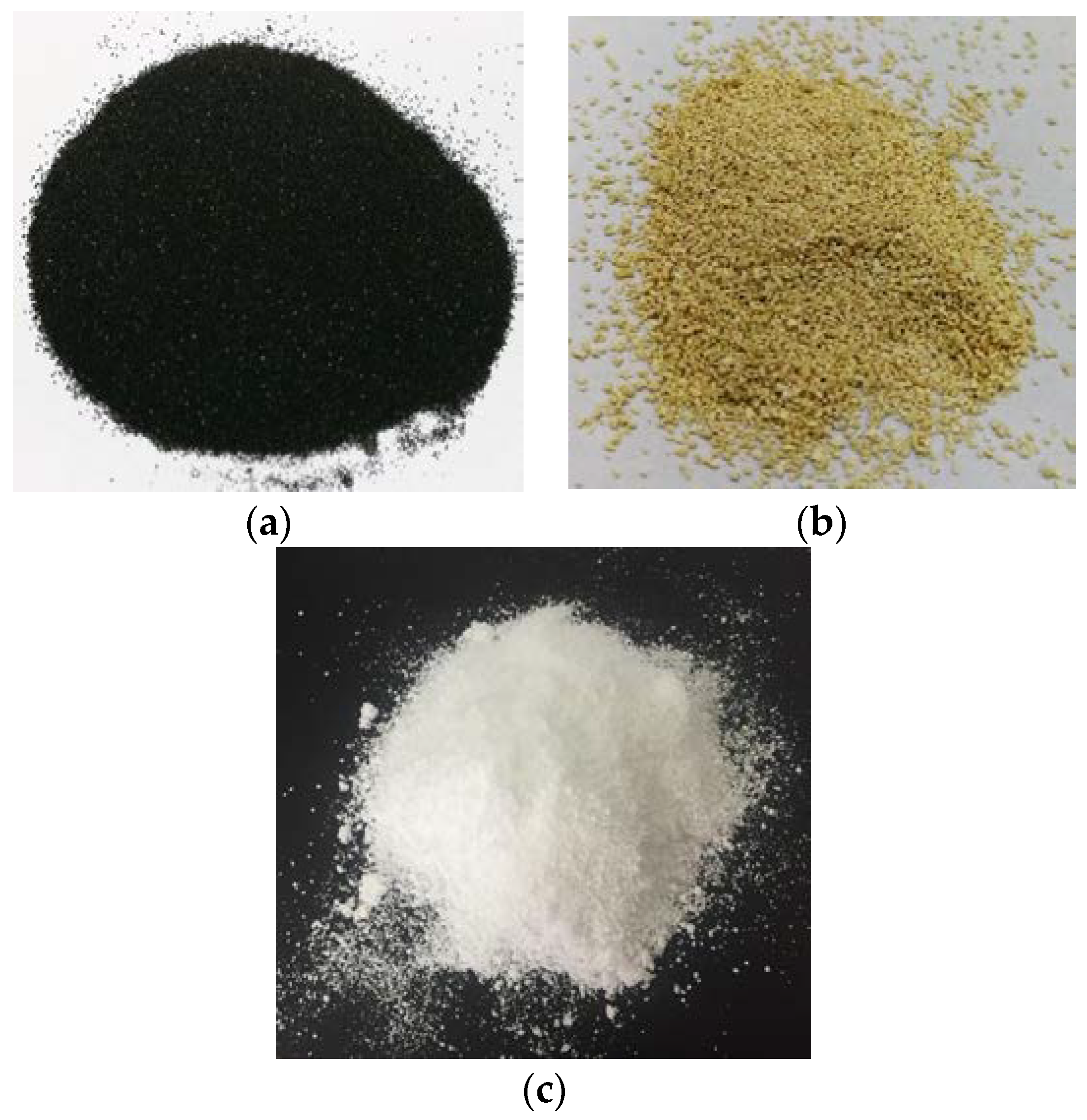


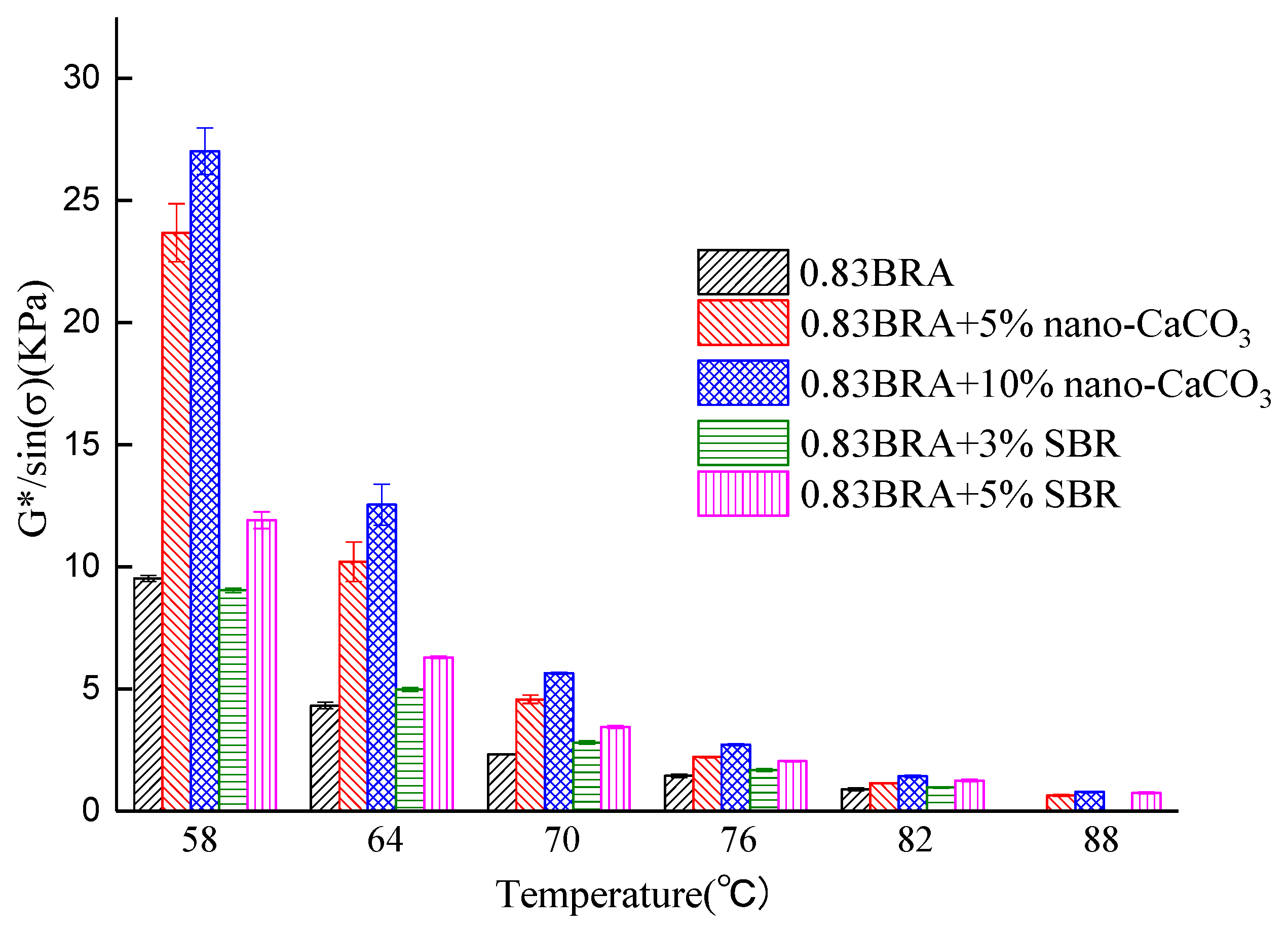
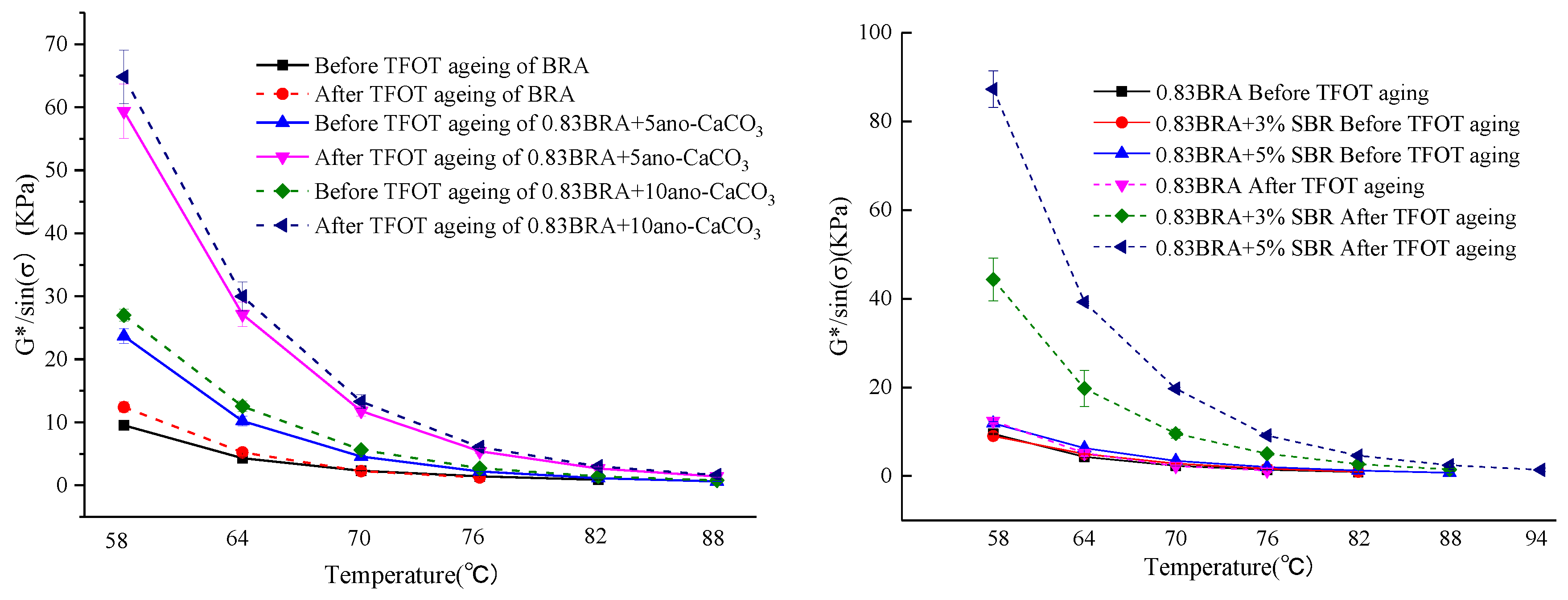
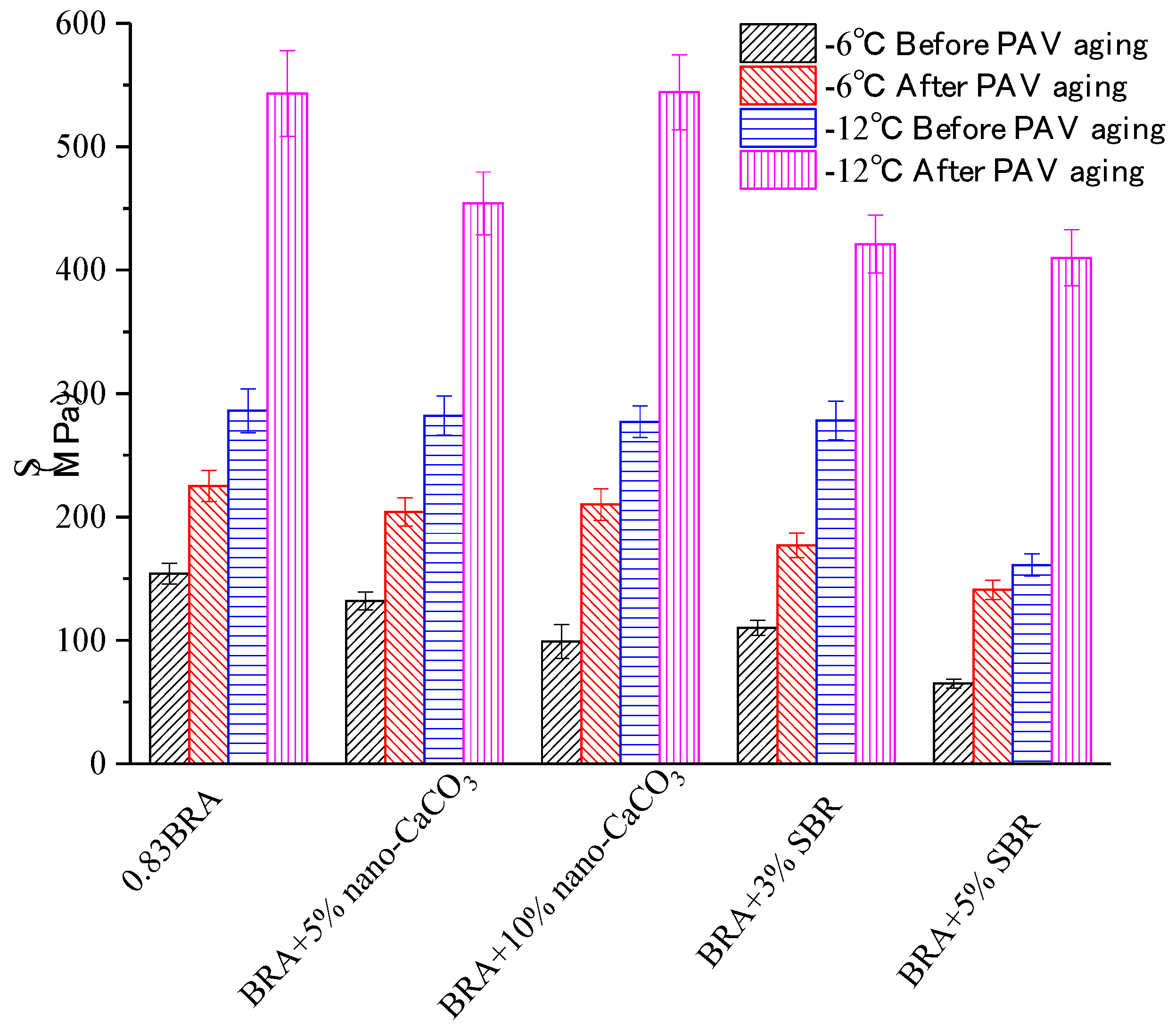
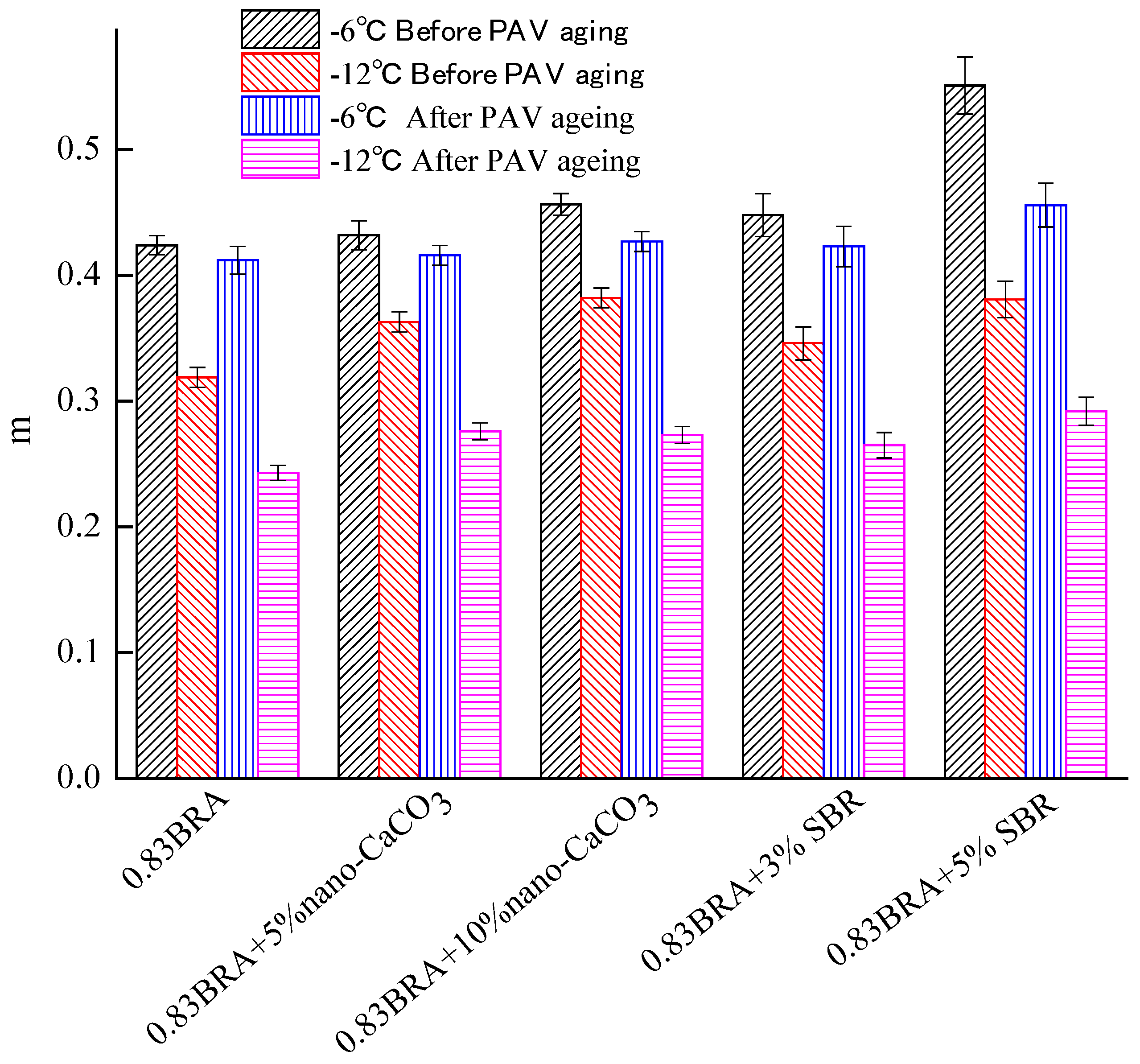




| Test Items | Industry Standard | Test Results | Test Methods [28] |
|---|---|---|---|
| Penetration at 25 °C (0.1 mm) | 60 | 75.2 | T 0604-2000 |
| Penetration Index | −2~2 | 0.968 | T 0604-2000 |
| Softening point (°C) | ≥100 | 51.5 | T 0606-2000 |
| Ductility at 15 °C (cm) | ≥46 | >150 | T 0605-1993 |
| Rotation viscosity/135 °C (Pa·s) | \ | 0.451 | T 0615-2000 |
| Test Items | Industry Standard | Test Results | Test Methods [29] | |
|---|---|---|---|---|
| Appearance | Brown powder | Brown powder | JT/T860.5-2014 | |
| Ash content (%) | <75 | 74.14 | ||
| Solubility (%) | >25 | 25.6 | ||
| Water content (%) | <2 | 0.97 | ||
| Percentage passing (%) | <4.75 mm | 100 | 100 | |
| <2.36 mm | 90~100 | 100 | ||
| <0.6 mm | 10~60 | 53 | ||
| Test Items | Industry Standard | Test Results | Test Methods | |
|---|---|---|---|---|
| Volatile matter content (%) | ≤0.60 | 0.30 | GB/T 6737 | |
| Ash content (%) | ≤0.50 | 0.10 | GB/T 4498 | |
| Organic acids content (%) | 4.50~6.75 | 6.15 | GB/T 8657 | |
| Soap content (%) | ≤0.50 | 0.01 | ||
| Bound styrene content (%) | 22.5~24.5 | 23.7 | GB/T 8658 | |
| Raw rubber Mooney viscosity [50 ML(1 + 4)100 °C] | 45~55 | 52 | GB/T1232.1 | |
| Compound rubber Mooney viscosity [50 ML(1 + 4)100 °C] | ≤93 | 70 | ||
| Tensile strength (MPa) | ≥25.5 | 25.8 | GB/T 8656 A | |
| Tensile elongation (%) | ≥340 | 412 | ||
| 300% fixed elongation stress at 145 °C (MPa) | 25 min | 17.7 ± 2.0 | 16.6 | |
| 35 min | 20.6 ± 2.0 | 20.8 | ||
| 50 min | 21.5 ± 2.0 | 21.6 | ||
| Test Items | Test Results | Test Methods [30] |
|---|---|---|
| Appearance | White powder | GB/T19590-2011 |
| Nano-CaCO3 content (%) | ≥98 | |
| PH value | 8.0~10.5 | |
| Whiteness (%) | ≥95 | |
| Activation rate (%) | ≥98 | |
| Volatile matter content at 105 °C (%) | ≤0.5 | |
| Insoluble matter content in hydrochloric acid (%) | ≤0.03 | |
| Passing rate for 45-μm experimental sieve (%) | ≤0.02 | |
| Oil absorption value (%) | ≤35 | |
| Insoluble matter content in hydrochloric acid (%) | ≤0.03 | |
| Passing rate for 45-μm experimental sieve (%) | ≤0.02 | |
| Oil absorption value (%) | ≤35 |
| Test Items | BRA | BRA + 3% SBR | BRA + 5% SBR | BRA + 5% Nano-CaCO3 | BRA + 10% Nano-CaCO3 |
|---|---|---|---|---|---|
| Penetration (25 °C, 0.1 mm) | 26.3 | 24.0 | 22.4 | 24.2 | 22.7 |
| PI | 1.862 | 1.703 | 1.961 | 1.870 | 1.912 |
| T1,2 (°C) | −18.8 | −16.6 | −17.1 | −17.7 | −17.0 |
| T800 (°C) | 73.5 | 73.7 | 76.5 | 73.5 | 74.7 |
| Softening Point (°C) | 64.7 | 75.8 | 81.4 | 65.4 | 66.9 |
| Ductility (5 cm/min, 15 °C, cm) | 7.5 | 20.1 | 26.7 | 8.4 | 12.8 |
| Test Items | BRA | BRA + 3% SBR | BRA + 5% SBR | BRA + 5% Nano-CaCO3 | BRA + 10% Nano-CaCO3 |
|---|---|---|---|---|---|
| Mass loss (%) | 0.343 | 0.279 | 0.260 | 0.254 | 0.229 |
| Penetration (25 °C, 0.1 mm) | 26.3 | 24.0 | 22.4 | 24.2 | 22.7 |
| Penetration of after TFOT aging (0.1 mm) | 18.8 | 22.5 | 21.4 | 21.2 | 20.4 |
| Penetration ratio (%) | 70.7 | 93. 8 | 95.5 | 87.6 | 89.9 |
| T (°C) | Asphalt Type | m | n | E1 (MPa) | E2 (MPa) | η1 (MPa·s) | η2 (MPa·s) | τ (s) | R2 |
|---|---|---|---|---|---|---|---|---|---|
| −6 | BRA | 0.123 | 321.869 | 546.8 | 302.0 | 33,912.3 | 8225.6 | 27.24 | 0.9989 |
| +3% SBR | 0.100 | 442.900 | 423.1 | 209.7 | 21,979.7 | 6223.6 | 29.68 | 0.9990 | |
| +5% SBR | 0.010 | 2634.839 | 357.9 | 127.0 | 9948.6 | 3930.3 | 30.95 | 0.9994 | |
| +5% nano-CaCO3 | 0.093 | 452.713 | 446.0 | 277.2 | 23,538.8 | 8207.3 | 29.61 | 0.9985 | |
| +10% nano-CaCO3 | 0.086 | 513.592 | 480.0 | 182.9 | 22,868.5 | 5118.1 | 27.98 | 0.9988 | |
| −12 | BRA | 0.159 | 321.821 | 717.6 | 680.1 | 66,678.5 | 16,874.3 | 24.81 | 0.9983 |
| +3% SBR | 0.168 | 275.811 | 706.5 | 631.0 | 66,919.3 | 16,043.5 | 25.43 | 0.9979 | |
| +5% SBR | 0.066 | 854.2 | 684.2 | 326.3 | 27,941.3 | 9520.7 | 29.18 | 0.9993 | |
| +5% nano-CaCO3 | 0.190 | 167.516 | 759.9 | 590.2 | 78,495.5 | 13,824.1 | 23.42 | 0.9976 | |
| +10% nano-CaCO3 | 0.152 | 392.156 | 691.7 | 678.2 | 64,479.4 | 15,774.8 | 23.26 | 0.9985 | |
| −18 | BRA | 0.215 | 192.268 | 1220.6 | 998.7 | 121,513.3 | 27,984.9 | 28.02 | 0.9988 |
| +3% SBR | 0.272 | 142.491 | 981.0 | 937.4 | 132,872.4 | 24,969.3 | 26.64 | 0.9985 | |
| +5% SBR | 0.148 | 1955.665 | 790.8 | 966.2 | 55,410.8 | 30,105.7 | 31.159 | 0.9999 | |
| +5% nano-CaCO3 | −20.539 | 0.005 | 1150.8 | 1848.8 | 65,875.3 | 55,528.0 | 30.03 | 0.9999 | |
| +10% nano-CaCO3 | −10.058 | 0.431 | 1128.3 | 1975.7 | 61,545.1 | 59,415.5 | 30.07 | 0.9999 |
© 2018 by the authors. Licensee MDPI, Basel, Switzerland. This article is an open access article distributed under the terms and conditions of the Creative Commons Attribution (CC BY) license (http://creativecommons.org/licenses/by/4.0/).
Share and Cite
Lv, S.; Wang, S.; Guo, T.; Xia, C.; Li, J.; Hou, G. Laboratory Evaluation on Performance of Compound-Modified Asphalt for Rock Asphalt/Styrene–Butadiene Rubber (SBR) and Rock Asphalt/Nano-CaCO3. Appl. Sci. 2018, 8, 1009. https://doi.org/10.3390/app8061009
Lv S, Wang S, Guo T, Xia C, Li J, Hou G. Laboratory Evaluation on Performance of Compound-Modified Asphalt for Rock Asphalt/Styrene–Butadiene Rubber (SBR) and Rock Asphalt/Nano-CaCO3. Applied Sciences. 2018; 8(6):1009. https://doi.org/10.3390/app8061009
Chicago/Turabian StyleLv, Songtao, Shuangshuang Wang, Tong Guo, Chengdong Xia, Jianglong Li, and Gui Hou. 2018. "Laboratory Evaluation on Performance of Compound-Modified Asphalt for Rock Asphalt/Styrene–Butadiene Rubber (SBR) and Rock Asphalt/Nano-CaCO3" Applied Sciences 8, no. 6: 1009. https://doi.org/10.3390/app8061009






